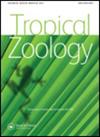利用相机陷阱对坦桑尼亚Udzungwa山脉中大型森林哺乳动物的精细尺度栖息地关联进行建模
IF 0.4
4区 生物学
Q4 ZOOLOGY
引用次数: 9
摘要
我们使用2013年从坦桑尼亚Udzungwa山脉60个地点收集的相机陷阱数据来确定中大型哺乳动物物种的精细栖息地关联。该地区因非洲的生物多样性和地方性而闻名,尤其是哺乳动物。每个相机陷阱取样30天,调查产生了26个物种的12911张图像。采用广义线性模型确定摄像机捕获事件与植被和其他生境变量之间的关系,结果表明,11个记录最多的物种中有9个获得了满意的模型拟合,模型解释偏差高达63.7%。结果为目标物种的生态学提供了新的见解。例如,世界自然保护联盟(iucn)濒危物种阿波特小羚羊(Cephalophus spadix)的事件数与到公园边界的距离呈正相关,表明它们更喜欢内部森林,避免受到干扰。东弧区特有的洛氏servalina genet (Genetta servalina lowei)的事件数与乔木多样性呈显著正相关,与能见度和草本盖度呈显著负相关,表明对成熟森林生境的偏好。我们的研究验证了摄像机陷阱在评估森林哺乳动物群落方面的有效性,特别是与栖息地关联相关的方面,提供了与森林哺乳动物保护管理相关的数据。本文章由计算机程序翻译,如有差异,请以英文原文为准。
Modelling fine-scale habitat associations of medium-to-large forest mammals in the Udzungwa Mountains of Tanzania using camera trapping
We used camera trap data collected in 2013 from 60 locations in the Udzungwa Mountains of Tanzania to determine fine-scale habitat associations for medium-to-large mammal species. The area is outstanding for biodiversity and endemism in Africa, particularly for mammals. Each camera trap sampled for 30 days and the survey yielded 12,911 images of 26 species. We used generalized linear modelling to determine relationships between camera-trapping events and vegetation and other habitat variables, and obtained satisfactory model fit for 9 out of the 11 most recorded species, with explained model deviance up to 63.7%. Results provide novel insights into the ecology of target species. For example, the event count of the IUCN-endangered Abbott's duiker (Cephalophus spadix) was positively correlated with distance to the park border, indicating preference for interior forest and avoidance of disturbance. The event count of the Eastern Arc-endemic Lowe's servaline genet (Genetta servalina lowei) was positively correlated with diversity of large trees but negatively correlated with visibility and herbaceous cover, indicating preference for mature forest habitat. Our study validates the usefulness of camera trapping to assess communities of forest mammals, especially as related to habitat associations, providing data that are of relevance to their conservation management.
求助全文
通过发布文献求助,成功后即可免费获取论文全文。
去求助
来源期刊

Tropical Zoology
生物-动物学
CiteScore
2.50
自引率
0.00%
发文量
1
审稿时长
>12 weeks
期刊介绍:
Tropical Zoology is an international zoological journal publishing original papers in the field of systematics, biogeography, phylogeny, ecology and conservation of all terrestrial and aquatic animal Phyla from tropical and subtropical areas.
Only papers with new information, high quality and broad interest are considered. Single species description and checklists are not normally accepted. Review papers are welcome. The journal is owned by the Istituto di Ricerca sugli Ecosistemi Terrestri of the Consiglio Nazionale delle Ricerche, Florence, Italy (CNR-IRET) who performs research into the structure and functioning of aquatic and terrestrial ecosystems, focusing in particular on anthropogenic pressure and global change. The knowledge amassed forms the scientific basis for identifying the most appropriate protective and corrective interventions, and provides support for the bodies entrusted with formulating policies for environmental protection and recovery.
 求助内容:
求助内容: 应助结果提醒方式:
应助结果提醒方式:


